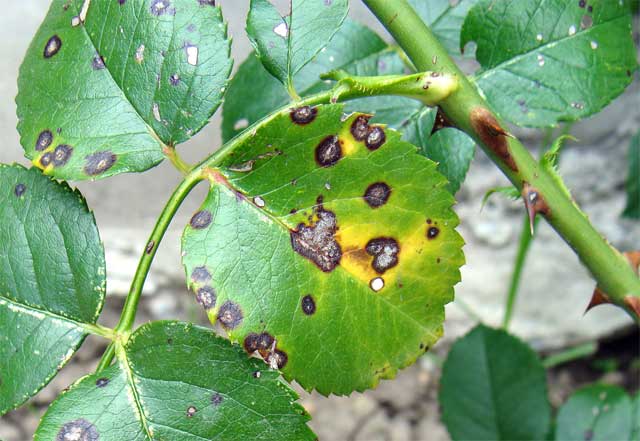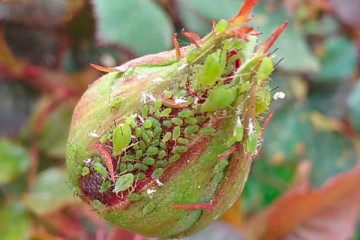Black spot on roses: reasons for the appearance, how to help the plant
Content:
Black spot on roses is a pathology that every gardener is afraid to see. The disease is severe, prone to seasonal exacerbation, and in the absence of timely treatment measures, it leads to the complete destruction of the flower.
Why does black spot appear
The path of transmission of the disease is drip. Infection occurs through the contact of the fungus on the rose with rain, during watering or when fog settles on the garden.
No roses are immune to black spot infestation. Most often, the disease occurs in the summer, in conditions of high humidity and high ambient temperatures.
Factors that provoke the onset of the disease
It takes a lot of effort and time to cure black spot. The disease is easier to prevent if you know what provoking factors increase the risk of its occurrence:
- Improper flower care, as a result of which the plant's immunity decreases. This is a combination of factors such as improper watering, lack of regular loosening, neglect of the need to make top dressing.
- Too dense bushes planted close to each other - the disease spreads very quickly from the affected plant to other roses.
- Lack of weeding, presence of weed near roses.
- Incorrectly chosen planting site - placing roses in a place where there is a lack of sunlight.
- Incorrectly selected fertilizers - nitrogen abuse or potassium deficiency.
The risk of spotting increases with frequent temperature changes and due to prolonged high humidity, for example, when it rains for a long time.

The disease develops gradually, for a long time the rose will delight with beautiful flowers, while the foliage loses juices and dies
Description of the disease
Black spot is a fungal disease, the causative agent is Marssonina rosae, the spores of which are carried with water. The fungus hibernates on foliage and young shoots, and by spring it wakes up simultaneously with the beginning of the vegetative period at the rose.
The spreading rate depends on the initial state of the rose, its immunity. In June, weak flowers show signs of the disease. Strong plants are affected by August-September. In autumn, with heavy and prolonged precipitation, high humidity in the air, an exacerbation occurs.
What does an affected rose look like, symptoms
Features of the manifestation of black spot on roses:
- First, the appearance of black spots on the leaves of the rose is found below.
- Affected leaf plates begin to quickly turn yellow and fall off.
- Gradually, the disease spreads up the bush.
- The spots are round and dark in color.
- From black, the spots become deep burgundy, and yellow at the edges.
After 1-2 weeks, small spots on the leaf merge into one large spot and the leaf blade dies.
Other types of spotting
There are many types of fungi that infect roses. In addition to black spot, there are the following common types:
- Powdery downy mildew - It is often confused with black spot. Symptom - spots of red color with a purple tint, which gradually turn black.
- Brown - spots of a round shape, no more than 6 mm in diameter, at the top there is a black border, at the bottom it is absent.
- Septoria spotting - the front side of the leaf is covered with small dots of a burgundy hue. After a while, they brighten, but the edging remains around them.
- Greyish spotting or cercosporosis. Brown circles with a purple tint appear on the leaf plates. The edging around them is gray. At the end of August, they turn into bulging spots, similar to balls. Leaves fall.
- Phylostic spotting - rusty spots form on the leaf, which quickly begin to turn brown and have a purple tint. With the development of spotting, the circles brighten, but the edging remains.
Regardless of what kind of spotting has arisen on the rose, all types of disease lead to the fact that the leaves begin to fall, and the flower soon dies.

Regardless of the type of spotting, the result for a flower, in the absence of measures, is one - its death
How to deal with black spot
If black spots appear on the leaves of a rose, how to treat them is the first question that is acutely faced by the gardener. You can get rid of the disease both with purchased drugs and folk remedies based on natural products.
Folk remedies and biologicals
It is quite difficult to deal with the disease, since it is prone to constant relapses under favorable conditions for it. Homemade recipes are used to treat roses only in the early stages, when only a few leaves have managed to be spotted.
The most effective recipes that give quick and good results:
- Iodine. Add 1 ml of antiseptic to 400 ml of water. Stir, process the leaves.
- Mullein - diluted with water in proportions of 1 to 10, leave for 2 days. Water the bush with the solution after wintering, until the buds appear.
- A large handful (about 30 g) of onion husks pour 2 liters of water, bring to a boil. Infuse the broth for 6 hours. The prepared substance is poured under the bush, a small amount of it must be moistened with the leaves.
Opponents of chemicals to eliminate spotting prefer to use biologics. While they cannot be called overly effective, they are more suitable for preventing the recurrence of the disease:
- Copper sulfate - you can use it only once a year, before the opening of the kidneys or in the last days of November. Dosage - 50 g of the drug per 1 liter of water.
- Strobi - the drug is used to prevent the further development of spotting on the rose. It is used systemically, every 10 days. For 10 liters of water, 10 g of the substance.
- Fitosporin - used from May to early November, it is used every week. If you miss one procedure, the disease can quickly reappear.
Chemicals
How to treat black spot on roses, if the disease has spread throughout the bush - the fight against a neglected case is possible only with chemical compounds - fungicides. They are divided into two groups:
- system contact: Profit Gold, Ordan, Quadris;
- systemic: Fundazol, Energy, Previkur, Topaz.
There is no difference in effectiveness between domestic and imported drugs. Chemicals must be used strictly according to the instructions.The composition of the solutions contains chemicals that require careful work with them, which is why the gardener must observe safety measures, working only with gloves and closing the respiratory system and vision.
Prevention of the appearance of black spot
Without regular prophylaxis, the rose will suffer from spotting regularly until the disease completely destroys it. What to do to protect the plant, every gardener should know:
- Rose bushes should be placed in sunny areas.
- Observance of sufficient space between roses. Even if one bush gets sick, other plants will be at least slightly protected from spotting for a while.
- Correct and timely pruning for sanitary purposes.
- Places of cuts after pruning are necessarily covered with charcoal.
- Correct use of fertilizers and their correct choice. An excess of nitrogen should not be allowed. Potassium intake should be regular.
- Watering - regular, at least 10 liters of water for each bush. In hot weather, the earth should be moistened 2 times a week; in cool weather, once is enough. It is important to avoid stagnant moisture.
- Loosening the soil and mulching are essential requirements for proper care of roses. It is necessary to loosen the ground after each watering.
- Timely treatment of other diseases and the destruction of parasites that weaken the plant's immunity, and significantly increase the risk of spotting.
Black spot is an insidious rose disease that tends to return as soon as the grower stops taking protective and strengthening measures. It is possible to save a plant from adversity only in the early stages, therefore it is so important to monitor the flowers in order to detect the first signs of pathology in a timely manner.



















